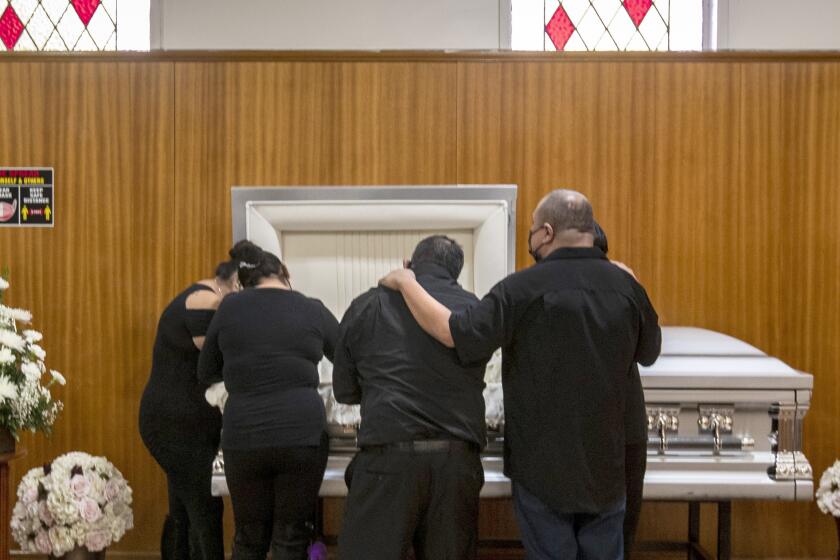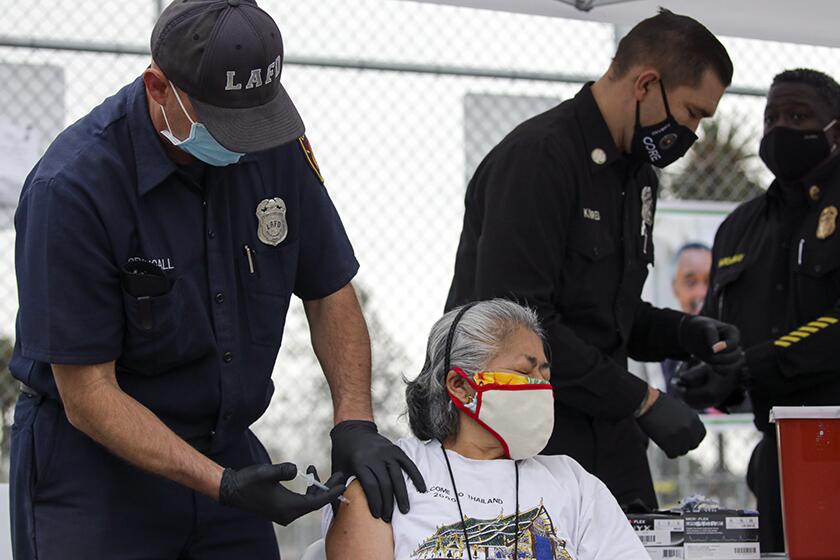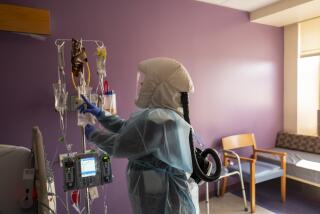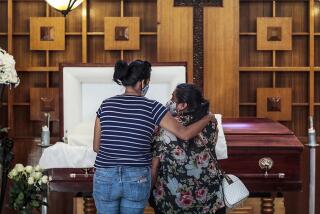L.A. County discovers 806 additional COVID-19 deaths overlooked in winter surge

Los Angeles County on Wednesday added more than 800 people to the list of those who had died of COVID-19, underscoring the massive toll of the fall and winter surge.
The addition means a leap in the total number of fatalities, which just this week reached 20,000 as deaths from the disease surpassed 50,000 in California.
Most of the deaths occurred during the autumn and winter surge, which overwhelmed hospitals and spurred new stay-at-home orders.
Here is what we know:
California has surpassed 50,000 COVID-19 deaths, a tally that came as Los Angeles County reported a backlog of more than 800
How were the additional deaths found?
The backlog of 806 new COVID-19 deaths in L.A. County, most of which occurred in December and January, was discovered following extensive checks of death records, Public Health Director Barbara Ferrer said Wednesday.
“This was a period, as you all know, where very many deaths occurred across the county. And not all of them were reported to [the Department of] Public Health because of the volume of records.”
The county typically identifies COVID-19 deaths by daily reports from healthcare providers. But the county also does an audit of the causes of death listed on death certificates. That audit is how the additional deaths were found, Ferrer said.
“The 806 deaths being reported today,” she said, “reflect those COVID-associated deaths that occurred during the surge that were not reported to Public Health through the death report form, but they were identified subsequently through our death certificate review, and we always do these reviews.”
The additional deaths account for about 8% of the total COVID-19 deaths in L.A. County in December and January, she added.
“It is heartbreaking to report on this large number of additional deaths associated with COVID-19,” Ferrer said. “And it’s a devastating reminder of the terrible toll the winter surge has taken on so many families across the county.”
Several counties could be eligible to resume indoor operations, but don’t expect changes in L.A. County anytime soon.
What’s the current outlook?
Despite the massive backlog reported Wednesday, both coronavirus deaths and cases have been plummeting in recent weeks.
California is recording about 6,000 new coronavirus cases a day now, down from 40,000 a day six weeks ago. The number of COVID-19 patients in California’s hospitals on Thursday was 6,185, down from a high of 21,936 recorded on Jan. 6.
The number of people in intensive care units statewide was 1,778 on Thursday, down 63% from a peak of 4,868 on Jan. 10 and the lowest such total since Dec. 1.
The picture is also dramatically improving in L.A. County.
Ferrer said Monday that daily coronavirus case counts in Los Angeles County were reaching lows not seen since before the winter surge. Over the last seven days, L.A. County recorded an average of 1,956 new coronavirus cases a day, down 87% from early January, when there were more than 15,000 new cases a day.
“We continue to make progress in reducing the average daily number of new cases of COVID-19,” Ferrer said.
L.A. County had also seen a decline in deaths prior to the reported backlog. In early January, the county recorded an average of 241 COVID-19 deaths a day over a seven-day period; for the most recent seven-day period, the county saw an average of 120 deaths a day, a decline of 50%.
Additionally, the county’s rate of positive test results, which exceeded 20% around Jan. 1, has fallen below 5%, Ferrer said.
The effective transmission rate in L.A. County has dropped from 0.81 a week ago to 0.76, meaning that for every 100 infected people, the virus is being transmitted to 76 people.
In L.A., so many people now have immunity to the coronavirus from past infections and vaccination that transmission is slowing and inching toward herd immunity.
What are the concerns going forward?
Overall, there is growing optimism that vaccines can fight COVID-19 and slow the spread considerably over time. One of the main problems is that vaccine supplies remain limited.
And officials are bracing for a rise in variants of the virus that are more transmissible, including a California strain that looks increasingly dangerous.
Officials were investigating a cluster of four coronavirus cases at USC, two of which are confirmed to be the more contagious and potentially more deadly variant first identified in Britain, B.1.1.7.
The two other cases are still awaiting lab confirmation, Ferrer said.
“All of these cases were detected as part of USC’s routine testing and surveillance program,” she said Wednesday. “The individuals are doing well, and they’re in isolation. Close contacts have been identified, notified, and they are in quarantine.”
Scientific research suggests that the currently available COVID-19 vaccines are effective against the U.K. variant.
“But with vaccine supply still very limited, the local transmission of the potentially more infectious U.K. variant underscores the need for every one of our residents to continue to use every tool we have to prevent transmission,” Ferrer said, “including not gathering with people you don’t live with, and distancing and masking whenever you’re out of your home and around others.”
There are now 18 confirmed cases of the U.K. variant in L.A. County, more than 200 in California and more than 1,800 nationwide, with 45 states reporting cases.
Los Angeles County Health Services Director Dr. Christina Ghaly on Tuesday noted that this week could bring increases in cases resulting from gatherings over Super Bowl weekend.
“An increase in the behaviors that facilitate transmission can still very easily lead to an uptick in the number of hospitalized patients in just a couple of weeks,” Ghaly said. “This can happen very quickly, and as we all know, it’s very difficult to then turn things around and start to force those numbers back down.”
More to Read
Start your day right
Sign up for Essential California for news, features and recommendations from the L.A. Times and beyond in your inbox six days a week.
You may occasionally receive promotional content from the Los Angeles Times.











